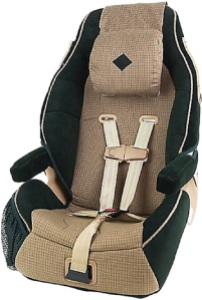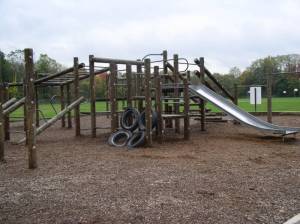I was coming home from the gym and hoping I didn’t get pulled over for driving while wheezing. As I was coming around a bend and searching with one blind hand for my “coming home triumphant” mix compact disc, there on the right side of the road, yellow shirt aglow in the late summer twilight, was a man on a bicycle. This guy had the whole get-up. The helmet. The shirt. The shorts. The shoes with the metal cleats. The little dentist’s mirror shooting out the left side of his helmet. The water bottle lashed against the powerful crossbar of the bicycle’s finely tuned structure.
I’ve always prided myself on being a friend to cyclists everywhere. So it was not a problem for me to drive 15 miles per hour behind the cyclist for the next few legs of our journey to give him plenty of road to enjoy his ride. I didn’t care about the line of cars behind me. Sharing the road means making sacrifices.
After a few miles I noticed through the honking that the cyclist was waving his hand at me in a circular motion, almost as if he wanted me to pass him. I thought he was just commending my respect for his bike riding, and I went on thinking this until the cyclist side-armed his water bottle at my car, and turned off into the adjacent wood. While I was in the body shop getting an estimate on the damage caused by the impact of a hurtling polyethylene projectile holding 24 oz. of water, I meditated upon the natural end of the war of the roads.
The cyclists, with their pro-environment image and greater amounts of sweat, will gain a greater and greater portion of the road. Eventually they will win their own stage of the traffic light-changing. At four-way intersections, the traffic signals will go through a whole cycle of green/yellow/red for the cyclists, while the cars must all stay at a complete stop, their operators presumably spending the time wisely by searching around for something in their cars.
The car owners, relegated to a smaller and smaller portion of the road, will become agitated and allow the interiors of their cars to become even more cluttered. The car owners organize, and begin a series of attacks on the well-being of cyclists. They publish reports of favorable biking weather when the report is really for a hurricane. They go to sporting goods stores and mix up all the water bottles, so that bottles without BPA intermingle with bottles that have questionable amounts of BPA. They follow cyclists at a slow pace when there is plenty of passing room.
The cyclists do not take this treatment sitting down. They organize as well, and begin attacking the well-being of the car owners. They start giving misleading hand signals. They start wearing more biking accessories. They start riding really slowly on narrow roads.
At some point the tension boils over and the two groups meet at a battlefield, like Gettysburg, or the Somme, or the parking lot at Best Buy. The cyclists and car owners line up at opposite ends of the field, and their leaders meet in the middle. The leaders of the cyclists cycle up, take a sip of water from their polyethylene bottles, and remove their helmets. The leaders of the car owners drive up, do a few three-point turns so that they’re all parked at the same angle, and stare ahead at the leaders of the cyclists, while a blind hand goes looking around for things inside their cars.
The leaders agree that it is in everyone’s best interest to resolve the dispute peacefully. The solution is the carcycle. The carcycle has the body of a car but instead of an engine, there are pedals connected to the axles. So you drive the carcycle just by pedaling. The jokes about the Flintstones go away after a few months, and both cyclists and car owners adopt the carcycle as the preferred mode of travel.
And there is peace throughout the land, until the people who ride on those stand-up scooters start clamoring for their share of the road.



